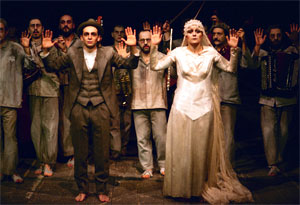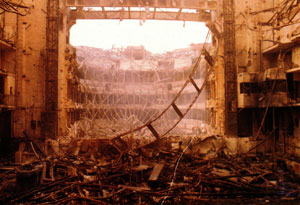Dybbuk

|
Genetic memory and urgency of the present. Dybbuk was our way to face the burning issue of the Shoah by transforming the pain of this inevitable encounter into live and pulsing matter. A theatre work difficult for me to catalogue as such, considering how deep the involvement which accompanied its gestation was. However, this show/non-show required an approach made of rigorous expressive and dramaturgic choices, in order to reach its goal.
A few are briefly outlined here; please refer to other pages • •
Text and dramaturgy |
|
In addition to Dalla sabbia dal Tempo, which I consider indispensable for the comprehension of this page, please see in regard to several subjects - Judaism, Moni, Teatro Franco Parenti - the following Il processo di Joseph K Note spettinate Famosi in tutta Europa Ballata di fine millennio and for an itinerary within the shadows of the theatre... Vanità delle vanità |
|
a show by Mara Cantoni and Moni Ovadia
|
|
|
|

|
It is better said immediately: Moni Ovadia's and Mara Cantoni's Dybbuk was not made for those who think it is possible or imperative to forget what happened in Europe half a century ago. And then again, perhaps it is precisely for them, in the same way remorse is for the guilty and justice for the unjust. (...) One hundred minutes of continuous, almost unbearable, emotions, with no holes or voids; at the end, a triumph... |
|
The photographs of Dybbuk are by Maurizio Buscarino |
|
The photographs of the
Teatro Petruzzelli are by Ansa and R.De Benedictis/Sintesi |

